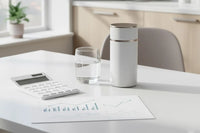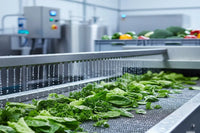Swab audits are where good plants go to die.
It doesn’t matter how long your sanitation team worked.
It doesn’t matter how clean the room looks under fluorescent lights.
If a single Listeria colony or an ATP spike shows up in your environmental sample…
You fail.
That failure costs you:
- Hours (or days) of emergency sanitation
- Batches put on hold
- Retesting and paperwork
- Auditor trust
- And sometimes, your next buyer contract
It’s the food industry equivalent of a sniper shot. Silent. Precise. Devastating.
And yet, most facilities keep using sanitation methods that set them up to fail:
- Chemicals that don’t penetrate biofilm
- Sprays that require rinse (and reintroduce risk)
- Foggers that leave residue or corrode surfaces
- Teams overwhelmed by PPE, rinse protocols, and SOP complexity
Hypochlorous acid (HOCl) changes that.
Not by cutting corners—but by cutting pathogens at the root.
The Swab Test Reality
Third-party audits, USDA FSIS checks, or internal QA teams typically swab:
- Drains
- Undersides of conveyors
- Slicers, tables, belts
- Air vents
- Gloved hands
- Floor-wall junctions
- RTE contact surfaces
- Post-sanitation “clean” zones
They test for:
- Listeria monocytogenes
- E. coli / Salmonella
- Total Aerobic Plate Count (APC)
- Total Yeast and Mold Count (TYMC)
- ATP (Adenosine Triphosphate) Residue
And when there’s residue, contamination, or colony-forming units (CFUs) above threshold?
⚠️ You fail.
Even one bad zone = corrective action.
How HOCl Helps You Pass
1. Penetrates Biofilms Where Bleach Fails
Pathogens like Listeria hide inside biofilms—microscopic protective layers on equipment and drains. Traditional quats and chlorine can’t reach through.
HOCl, thanks to its neutral charge and oxidative mechanism, penetrates and destroys biofilm structures, eliminating hidden colonies before they show up on a swab.
2. No Residue = Lower ATP Readings
ATP meters detect all organic residue—not just pathogens. Leftover sanitizer = higher ATP = false failures.
Quats, PAA, and peroxides leave trace residues.
HOCl does not.
It evaporates cleanly into saline water—leaving no organic trace to trigger swab failures.
3. Safe for Mid-Shift Reapplication
Some zones need sanitation during production, not just pre-op.
But you can’t fog bleach while people are working. You can’t spray PAA onto belts between runs without PPE.
You can with HOCl.
Sanitation teams can re-spray, dip, or fog mid-shift—without PPE, re-entry delays, or product risk.
This means cleaner conditions all day long, not just when the inspector arrives.
4. Standardized PPM Control with On-Site Generation
EcoloxTech HOCl generators allow you to:
- Produce HOCl fresh, on-demand
- Monitor and adjust PPM levels in real time
- Standardize application across shifts and zones
- Eliminate errors from chemical dilution or expired stock
Consistent ppm = consistent kill = consistent swab pass rates.
Real Facilities Using HOCl to Crush Swab Audits
Cheese Facility – Midwest USA
Problem: Inconsistent ATP readings on packaging tables. Quat fogger left sticky residue.
Switch: Installed HOCl generator with handheld foggers.
Result:
- ATP scores dropped by 78%
- Swab fail rate reduced from 6.3% to <1%
- Passed GFSI audit with highest sanitation score in 3 years
Seafood Processor – Southeast
Problem: Failed FDA inspection due to Listeria in drain zones.
Switch: HOCl fogging and drain spray at 200 ppm, nightly.
Result:
- 100% kill of Listeria in 7 days
- Passed reinspection
- Drain swabs remain negative 90 days later
RTE Facility – California
Problem: Aerobic plate count spikes on gloved hands between changeovers. Quats irritated skin and dried gloves.
Switch: HOCl glove dip stations at 100 ppm.
Result:
- Skin irritation eliminated
- TYMC dropped 85%
- Swab failures on gloves: 0 in 3 months
Bonus: Audit Support in the Binder
When you use HOCl, your audit documentation includes:
- ✅ EPA registration numbers (List K, List N)
- ✅ FDA GRAS classification
- ✅ USDA Organic compliance (NOP)
- ✅ NSF D2 no-rinse certification
- ✅ SDS sheets and PPM charts
- ✅ Fogging and swab SOPs
- ✅ Side-by-side comparisons with bleach, PAA, ozone, and quats
Auditors don’t just approve HOCl—they often commend it.
Final Word: Swabs Don’t Lie. Neither Should Your Chemistry.
If your sanitation system is still failing swabs, don’t blame your team.
Blame your chemistry.
Most systems leave residue, create biofilms, or evaporate before the kill is complete.
They work in theory. They fail in reality.
HOCl is the rare molecule that’s strong enough for the kill—and clean enough for the swab.
- No residue.
- No rinse.
- No excuses.
Want Audit-Proof Swab SOPs?
📩 Download the HOCl Sanitation Blueprint, including:
- ATP + CFU swab SOPs with HOCl
- PPM usage guides for drains, belts, gloves, and fogging
- Case studies from USDA + FDA plants
- Full compliance packet and SDS
- ROI calculator for replacing bleach, quats, and PAA





